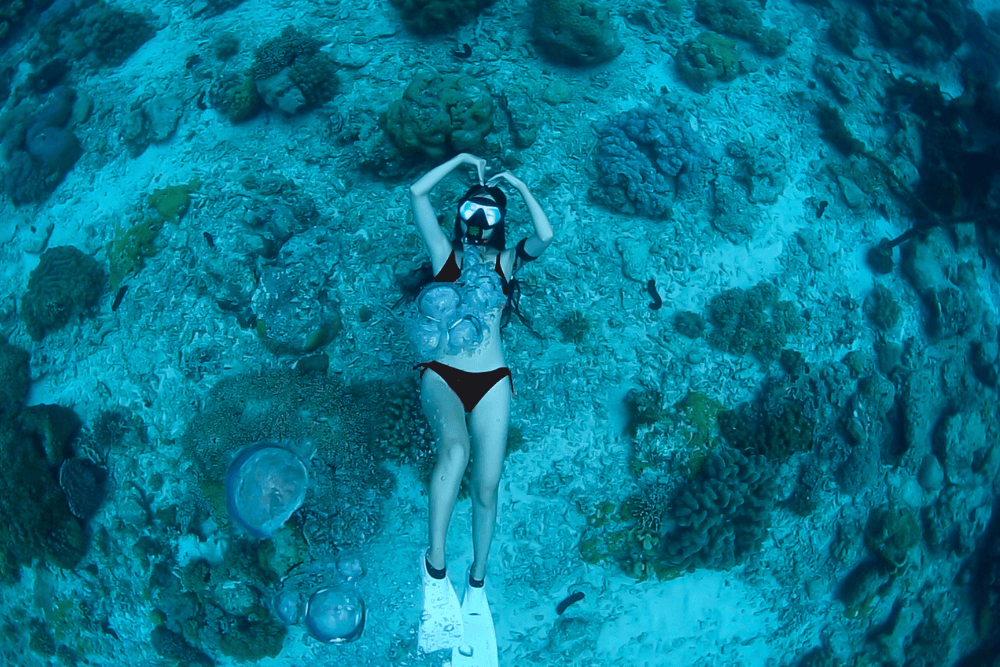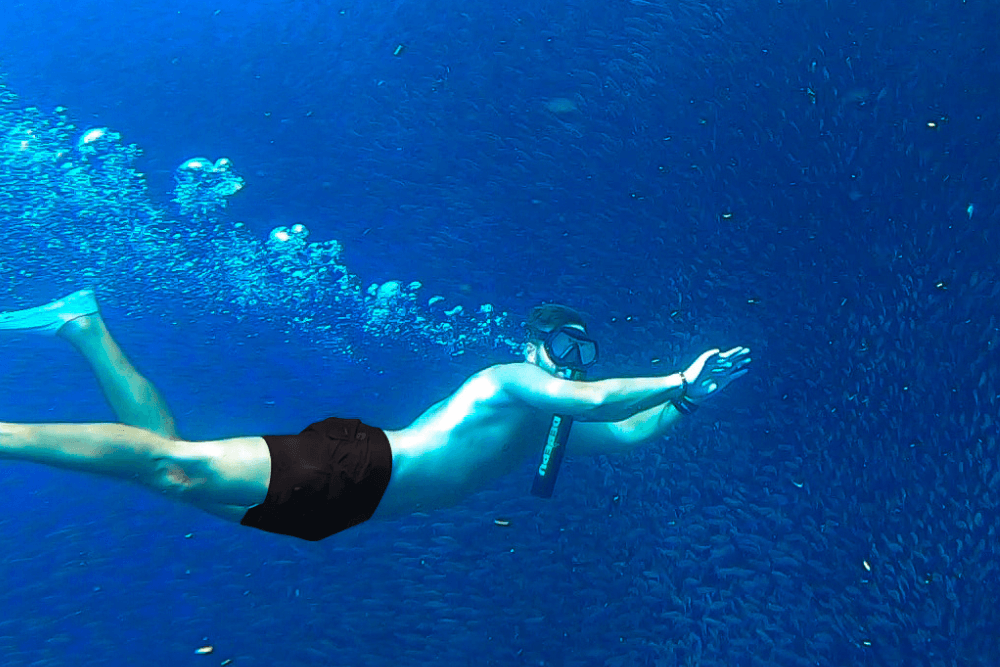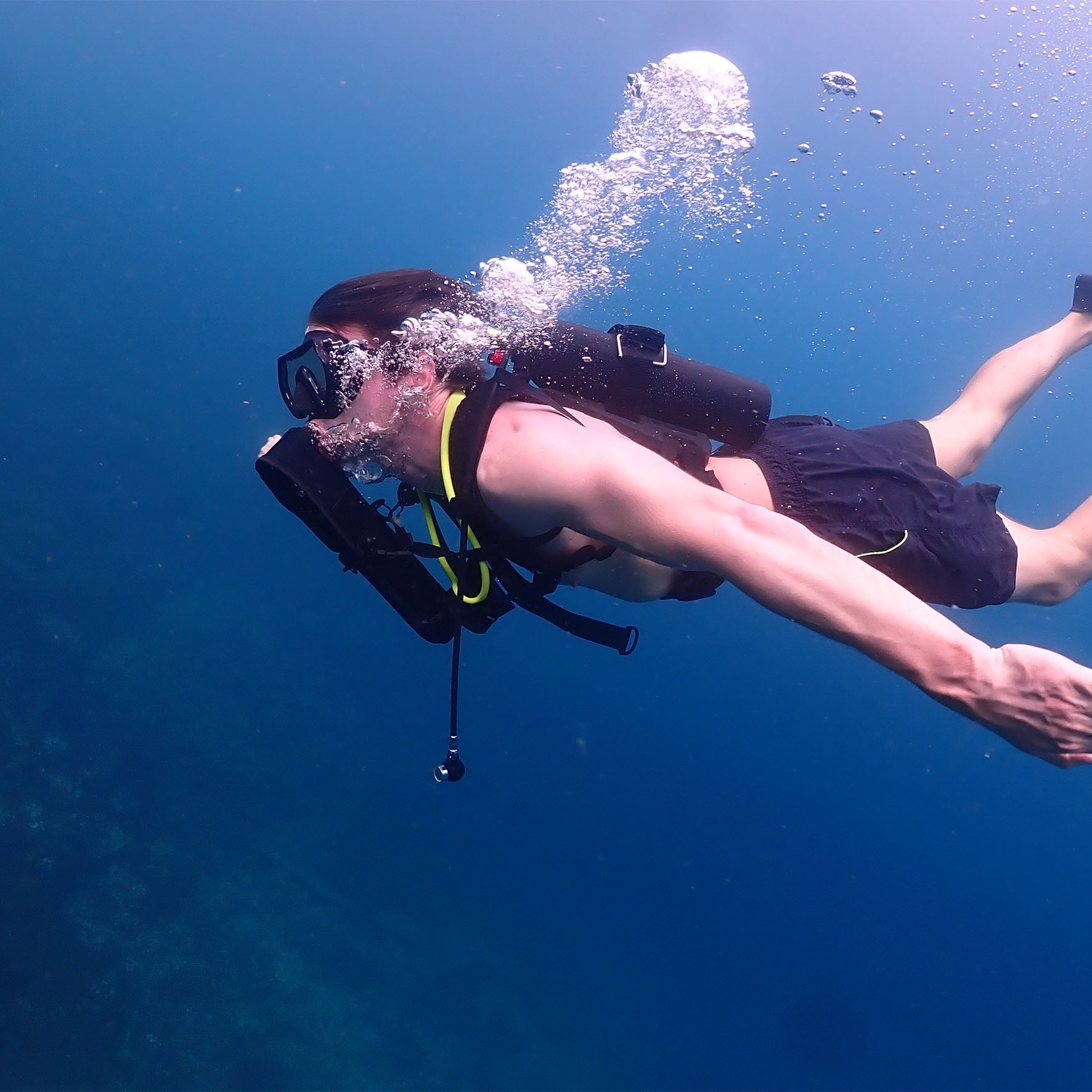Flying after scuba diving risks decompression sickness ("the bends") because cabin pressure changes (equivalent to 8,000 ft altitude) can cause nitrogen bubbles to form in your bloodstream. Wait 12-24 hours after a single dive (or 18+ hours for multiple dives) to allow nitrogen to safely dissipate. Deeper dives (below 18 meters) require longer waits. Always follow PADI/SSI guidelines based on your dive profile. Symptoms like joint pain or dizziness can appear mid-flight.
Nitrogen in Your Blood
When you dive, your body absorbs nitrogen gas from the breathing mix—at 30m depth, you take in 4x more nitrogen than at the surface. A single 60-minute dive to 18m can saturate your tissues with 1.5L of dissolved nitrogen, which needs 12-24 hours to fully release. The deeper and longer you dive, the more nitrogen builds up—at 40m, your blood carries 6.25x the surface nitrogen levels, requiring careful management to avoid decompression sickness (DCS).
Nitrogen Elimination Rates
The half-life of nitrogen elimination varies by tissue type. Fast tissues like blood and muscles release 50% of absorbed nitrogen in 20 minutes, while slow tissues (joints, fat) take 5-12 hours for the same reduction. After a multi-day dive trip, slow tissues may still hold 10-15% residual nitrogen even after surface intervals. This is why repetitive dives increase risk—each subsequent dive adds 30-50% more nitrogen load if you don’t allow enough time between them.
Decompression Models
The US Navy tables recommend 8 hours before flying after a single no-decompression dive, while PADI’s recreational guidelines suggest 12 hours for conservative safety. Technical divers using trimix or extended bottom times may need 18-24 hours due to higher nitrogen saturation. Flying too soon reduces cabin pressure to 0.75 atmospheres, which can expand remaining nitrogen bubbles by 25%, increasing DCS risk 5x.
DCS Symptoms
Joint pain (the "bends") occurs when 0.1mL of free gas accumulates in a joint space. Neurological DCS (tingling, confusion) starts at 0.05mL bubbles in spinal fluid. Pulmonary issues arise when 1-2mL of gas blocks lung capillaries. The probability of DCS jumps from 1% after proper surface intervals to 15% if flying within 4 hours of diving.
Optimizing Nitrogen Release
Drinking 500mL of water per hour speeds elimination by 20% by improving blood flow. Light exercise (walking) helps, but intense workouts slow nitrogen off-gassing by 10% due to diverted circulation. Avoid alcohol—it dehydrates and doubles bubble formation risk. For the safest recovery, rest in a horizontal position for 2-3 hours post-dive, which improves circulation efficiency by 30% compared to sitting upright.
 How Depth Affects Nitrogen Absorption
How Depth Affects Nitrogen Absorption
At 10m (33ft), the pressure is 2 atmospheres (ATM), doubling nitrogen absorption compared to the surface. By 30m (100ft), you're at 4 ATM, absorbing 4x more nitrogen per minute than at sea level. This exponential relationship means a 15-minute dive to 30m loads your tissues with the same nitrogen as 60 minutes at 10m.
Depth vs. Nitrogen Absorption Rates
| Depth | Pressure (ATM) | Nitrogen Absorption Rate | Equivalent Surface Time |
|---|---|---|---|
| 5m (16ft) | 1.5 ATM | 1.5x surface rate | 30min dive = 45min surface time |
| 12m (40ft) | 2.2 ATM | 2.2x surface rate | 20min dive = 44min surface time |
| 18m (60ft) | 2.8 ATM | 2.8x surface rate | 15min dive = 42min surface time |
| 30m (100ft) | 4 ATM | 4x surface rate | 10min dive = 40min surface time |
No-Decompression Limits
At 12m, recreational divers can stay 200 minutes without mandatory decompression stops. At 18m, this drops to 56 minutes, and at 30m, just 20 minutes. These limits exist because 95% of DCS cases occur when divers exceed no-deco times by 15+ minutes. The body needs 50% longer to eliminate nitrogen from a 30m dive than from an 18m dive of the same duration.
Tissue Saturation Variations
Fast tissues (blood, muscles) reach 90% saturation in 20 minutes at 30m, while slow tissues (joints, fat) only reach 40% saturation in the same time. However, slow tissues retain nitrogen 5x longer—after a 30m dive, fat tissues may still release nitrogen bubbles 12 hours later. This is why deep divers must wait longer before flying—a 40m dive requires 24+ hours surface interval versus 12 hours for an 18m dive.
Safety Stop Importance
A 3-minute stop at 5m after a 30m dive reduces residual nitrogen by 15%, cutting DCS risk in half. Some dive computers add deep stops—pausing at 50% of max depth for 1-2 minutes—which lowers nitrogen loading in fast tissues by 20%. Without these stops, microscopic bubbles form in 60% of deep divers, though only 5% develop symptoms.
Pro Tip
Use the rule of thirds for deep dives—go down to 1/3 of your max planned depth first to check conditions. If diving below 30m, bring a pony bottle with 40% more gas than your primary tank. Always monitor your computer's nitrogen loading graph—if it shows >70% saturation in any tissue group, extend your surface interval by 30 minutes per 10% overage.
Standard Waiting Times
For a single no-decompression dive to 18m (60ft), the standard wait is 12 hours—this allows 90% of absorbed nitrogen to safely release. Multi-day divers doing 4+ dives per day should wait 18-24 hours, as repetitive dives increase residual nitrogen by 30-50% per dive. Technical divers exceeding recreational limits need 24-48 hours, especially after dives deeper than 30m (100ft) where tissues absorb 4x more nitrogen.
Key Waiting Time Benchmarks
- Single dive <12m (40ft): Minimum 8 hours before flying
- Single dive 12-18m (40-60ft): Recommended 12 hours surface interval
- Multiple dives per day (3+ dives): Extend to 18 hours minimum
- Decompression dives (required stops): 24+ hours mandatory
- Technical mixed-gas dives: 48 hours for complete off-gassing
Dive Computer Calculations
Dive computers track fast and slow tissues to personalize wait times—they may approve flying after 10 hours for conservative divers, while requiring 15 hours for those pushing limits. Computers using RGBM algorithms add 20% more safety time than older Haldane models, reducing DCS risk by 50%. Always follow your computer’s most conservative reading—ignoring it increases DCS probability from 1% to 5%.
Altitude Considerations
Flying within 24 hours of diving exposes you to 0.75 ATM cabin pressure, expanding any remaining nitrogen bubbles by 25%. If traveling to high-altitude destinations (>300m/1000ft) after diving, add 12 extra hours to standard wait times—the lower atmospheric pressure behaves like an additional flight risk. Some dive computers have altitude modes that adjust no-fly times automatically—using this prevents 80% of altitude-related DCS cases.
Health & Hydration Impact
Dehydrated divers eliminate nitrogen 20% slower, effectively extending wait times by 2-3 hours. Smokers face 30% longer clearance times due to reduced lung efficiency. Light exercise (walking) during surface intervals improves circulation, cutting wait times by 10%, while alcohol consumption doubles bubble formation risk, negating any time advantage.
Pro Tip
Plan your last dive day with waiting times in mind. Schedule flights for afternoon or evening to maximize surface intervals—a 7 AM flight forces a 12-hour wait beginning at 7 PM the night before, limiting dive options. For liveaboard trips, book onboard accommodations for an extra night—this provides 24+ hours of guaranteed off-gassing before travel. If emergencies require early flying, bring your dive computer log—some airlines permit oxygen use during flight to reduce DCS symptoms if they occur.

Emergency Exceptions
In rare cases, divers must fly before completing standard waiting periods—medical evacuations occur in 1 out of 5,000 dive trips, while family emergencies force 3% of divers to alter plans. The risk of decompression sickness (DCS) jumps from 1% to 15% when flying within 4 hours after diving, but certain protocols can reduce dangers. Military and commercial divers use oxygen pre-breathing for 30-60 minutes before emergency flights, cutting bubble formation by 50%. Helicopter evacuations typically maintain sea-level cabin pressure, unlike commercial flights at 0.75 ATM, reducing expansion risks by 25%.
Controlled Ascent Strategies
If you must fly within 12 hours of diving, limit your last dive to <12m depth and keep it under 30 minutes—this reduces nitrogen loading by 70% compared to standard profiles. Stay hydrated with 500mL water per hour to accelerate off-gassing by 20%, and avoid alcohol completely—it doubles bubble growth rates. Some dive computers have an emergency flight mode that recalculates nitrogen levels—using this feature provides 30% more accurate risk assessment than guessing.
In-Flight Oxygen Use
Airlines carry emergency oxygen masks providing 4L per minute, enough to slow bubble growth by 40%. Passengers needing oxygen must notify crew 48 hours before departure—last-minute requests get approved only 60% of the time. If symptoms appear mid-flight (joint pain, dizziness), immediate oxygen use and landing at the nearest airport cuts permanent injury risk from 20% to 5%.
Critical Steps for Early Flights
- Document dive profiles—note max depth, bottom time, and surface intervals for medical staff
- Request ground-level cabin pressure—some air ambulances can maintain 1 ATM if arranged in advance
- Wear compression garments—flight socks and sleeves reduce bubble migration risk by 15%
Post-Flight Monitoring
After emergency flights, watch for DCS symptoms for 24 hours—80% of cases appear within 8 hours, but delayed onset happens in 20%. Hyperbaric chambers should be located within 4 hours travel of your destination—the first 6 hours after symptom onset are crucial for effective treatment. Divers flying early should avoid heavy exercise, hot tubs, or massages for 48 hours—these activities increase bubble formation rates by 30%.
Pro Tip
Carry your dive computer logbook when traveling—it provides doctors with precise data if treatment is needed. DAN (Divers Alert Network) members get 24/7 emergency hotline access—their physicians handle 200+ flight-related DCS cases annually. For high-risk situations, consider commercial dive insurance covering hyperbaric treatment costs—a single chamber session averages 90 minutes at 2.8 ATM, typically requiring 3-5 sessions for full recovery.

Safety Check Steps
Flying after diving requires specific precautions to minimize decompression sickness (DCS) risks. Studies show 90% of DCS cases occur when divers ignore pre-flight safety checks. A proper verification process takes 15-20 minutes but reduces DCS probability from 5% to under 1%. The key metrics to monitor include nitrogen saturation levels (<70% in any tissue group), hydration status (1.5L urine output in 4 hours), and time since last dive (minimum 12 hours for recreational profiles).
Pre-Flight Safety Verification Table
| Checkpoint | Ideal Value | Risk Threshold | Measurement Method |
|---|---|---|---|
| Surface Interval | 18+ hours | <12 hours | Dive computer log |
| Hydration | >1.5L urine/4hr | <0.5L/4hr | Urine color chart |
| Nitrogen Loading | <50% tissue saturation | >70% saturation | Dive computer display |
| Final Dive Depth | <18m (60ft) | >30m (100ft) | Dive profile review |
| Physical Symptoms | None | Any joint pain | Self-assessment |
Critical Pre-Flight Checks
- Review your dive computer's nitrogen graph—ensure no tissue group exceeds 60% saturation
- Perform a mobility test—rotate all major joints through full range of motion watching for discomfort
- Check circadian rhythm—flying when sleep-deprived increases DCS susceptibility by 40%
Equipment Preparation
Pack your regulator in carry-on luggage—22% of checked dive bags get delayed, leaving you without crucial evidence if symptoms emerge. Bring printed copies of dive profiles and computer readouts—these help medical staff diagnose 50% faster if treatment becomes necessary. Ensure your DAN membership card is accessible, as it provides 24/7 emergency consultation and covers 90% of hyperbaric treatment costs worldwide.
In-Flight Precautions
Choose aisle seats when possible—getting up every 90 minutes improves circulation by 30%, aiding residual nitrogen off-gassing. Drink 250mL water hourly to maintain hydration—cabin air has 10-20% humidity, causing 2L fluid loss on a 4-hour flight. Avoid alcohol completely—it triples bubble formation risk by dehydrating tissues and slowing circulation. If available, use compression socks (15-20mmHg pressure) to reduce venous gas bubble accumulation by 25%.
Post-Flight Monitoring
85% of DCS symptoms appear within 8 hours of landing, but delayed onset occurs in 15% of cases. Schedule light activity only—walking 5,000 steps/day aids circulation without the risks of intense exercise. Have emergency contacts programmed in your phone, including the nearest hyperbaric chamber location—treatment within 4 hours of symptom onset improves recovery rates from 60% to 95%.
Pro Tip
Download your dive computer data before airport security—some older models lose logs when going through X-ray scanners. Keep a printed dive log in your wallet as backup. If flying within 24 hours of diving, wear a medical alert bracelet noting recent dive activity—this speeds emergency response by 40% if symptoms develop mid-flight. For international trips, verify your insurance covers hyperbaric treatment abroad—a single chamber session averages $1,800 without coverage.




Laisser un commentaire
Tous les commentaires sont modérés avant d'être publiés.
Ce site est protégé par hCaptcha, et la Politique de confidentialité et les Conditions de service de hCaptcha s’appliquent.